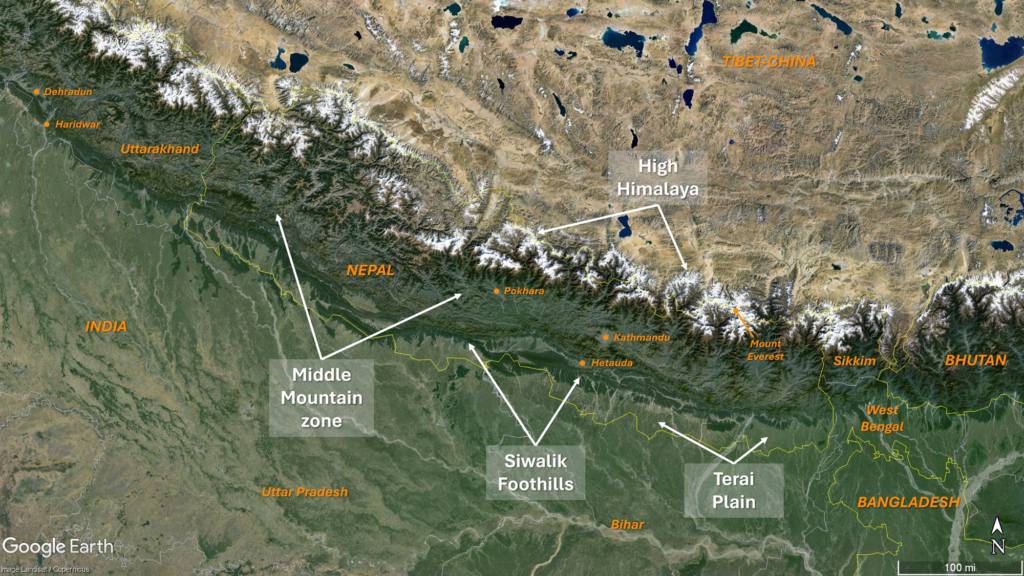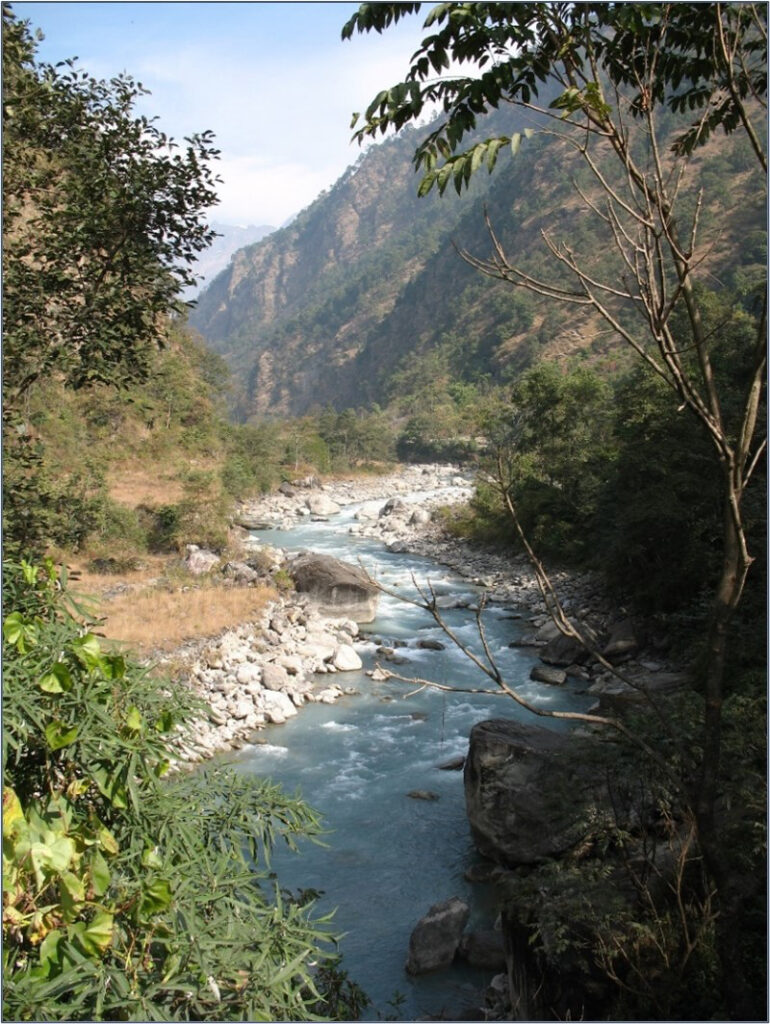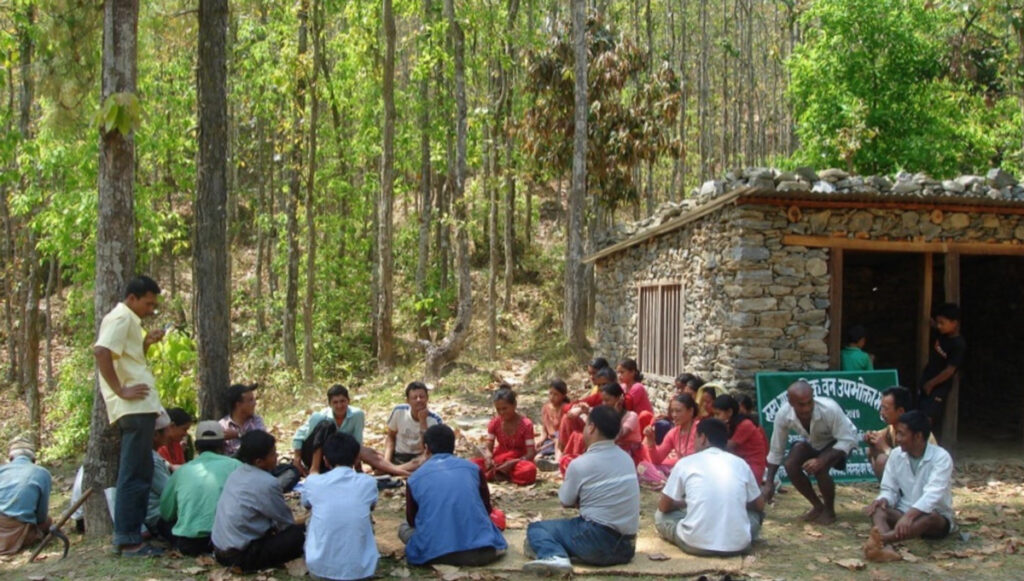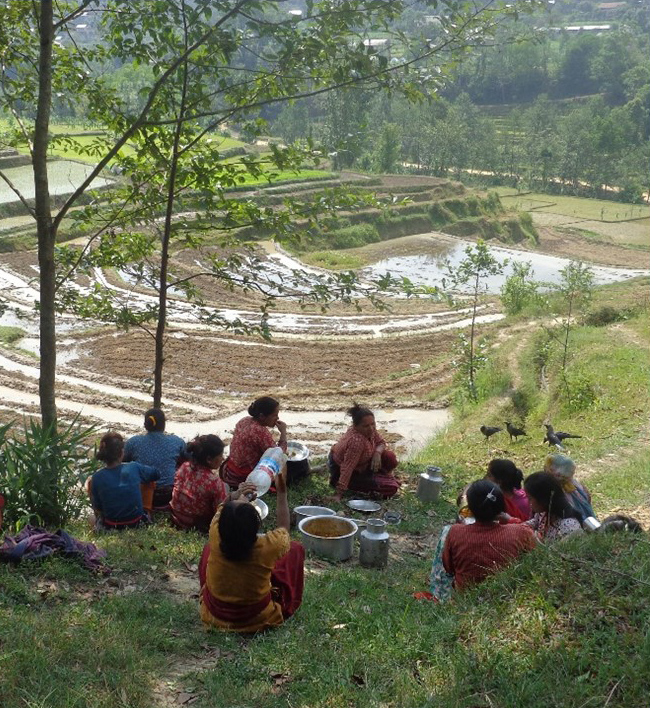The Himalayan mountain chain and the adjacent Tibetan Plateau together form one of the world’s major water towers, sustaining several of Asia’s largest rivers and providing water to more than a billion people in the surrounding lowlands.
The mountain chain, which stretches across northern Pakistan, northern India, Nepal, and Bhutan, broadly comprises the High Himalaya and the Lesser Himalaya. The Lesser Himalaya—taken here to include the Middle Mountain zone, Siwalik foothills, and Terai plain—is characterized by much denser human habitation and primarily rain-fed water supplies at elevations mostly below 3,000 meters (Figure 1).

The vulnerability to global warming of the higher, ice-covered parts of the region (often referred to as the “Third Pole”) and the resulting changes in downstream water provisioning are intensively studied.
More than 80% of the total streamflow emanating each year from the Himalayan mountain chain derives from rain falling in the Lesser Himalaya.
In contrast, the hydrological implications of changes in climate and, especially, in land use and land cover that have taken place over the past half century in the Lesser Himalaya have received far less scientific attention. These implications are critically important, however, as more than 80% of the total streamflow emanating each year from the mountain chain (excluding the westernmost and easternmost parts) derives from rain falling in the Lesser Himalaya [Bookhagen and Burbank, 2010].
Five decades ago, planting fast-growing (mostly native) pine trees to restore degraded upland forest lands in the Lesser Himalaya, particularly in Nepal, was seen as a remedy for downstream flooding and sedimentation problems. Although this effort helped to stem local soil erosion and provided much needed fuelwood to hill dwellers, the thirsty pines also contributed to reduced spring flows and streamflows, creating new problems in the region. Climate change, human migration to urban centers, abandonment of rain-fed agriculture, and other interacting factors have added further complexity to the mounting water management problems challenging the people of the Lesser Himalaya.

In September 2023, an international symposium was held in Pokhara, Nepal, to review past and present connections among water, forests, and rural livelihoods in the Lesser Himalaya and to shed light on the specific challenge of declining spring water supplies [Sun et al., 2023]. The meeting brought together experts—mostly from Nepal, with others from China, India, the Netherlands, and the United States—in forest hydrology and ecology, water resources management, community forest management, socioeconomic dynamics, and climate change. Representatives of international institutions (e.g., the United Nations Environment Programme and the International Centre for Integrated Mountain Development), national and provincial government officials, and regional journalists also attended. Among the meeting’s outcomes, the group identified key knowledge gaps with respect to forest-water-livelihood relationships in the Lesser Himalaya, as well as steps to fill these gaps.
The Hills Regreened
Until the mid-1980s, it was generally assumed by scientists and policymakers alike that widespread degradation and loss of forests resulting from agricultural cropping and grazing in the Lesser Himalaya were the primary causes of flooding and sedimentation problems experienced on the plains of Bangladesh and northern India. This view was ultimately found to be untenable, as other factors, including the region’s naturally steep, unstable topography, seasonally concentrated rainfall, and frequent tectonic activity, were shown to have much greater influence on lowland flooding and sediment export at the regional scale [Bruijnzeel and Bremmer, 1989; Hofer and Messerli, 2006].
Within the Lesser Himalaya, however, advanced forest degradation and loss still had adverse local hydrological effects. These effects included accelerated erosion on farm fields and associated losses of plant productivity, as well as reduced rainfall infiltration and groundwater recharge that adversely affected flows of locally important springs and headwater streams.

A major reforestation program, initiated in the mid-1970s by the Nepalese government with Australian assistance, mostly involved planting pine trees on degraded land across the Middle Mountain zone of Nepal. In the late 1970s, community-based forest management practices and government regulations were introduced and expanded, which gradually curtailed the traditional but unsustainable extraction of large amounts of animal fodder, fuelwood, and litter material from native broad-leaved forests that supported subsistence agriculture.
Forests across the Nepalese Lesser Himalaya have improved remarkably over the past 30 years in both extent and condition.
Today, nearly 40% of Nepal’s forests are managed by local Community Forest User Groups. These groups are required by law to reinvest 25% of the income generated from selling forest products in forest development and to divide the remainder equally between socioeconomic development and community welfare. Largely because of these efforts, forests across the Nepalese Lesser Himalaya have improved remarkably over the past 30 years in both extent—forest cover grew from roughly 29% in 1994 to 45% in 2011—and condition [Hobley et al., 2013; Gao et al., 2023].
A substantial trend of (mostly younger) people migrating from rural upland areas to seek potentially more lucrative or stable employment in regional semiurban and urban centers (e.g., Dehradun and Haridwar in India and Pokhara and Kathmandu in Nepal), as well as farther abroad (e.g., Southeast Asia and the Middle East), has also contributed to the regreening of the Lesser Himalaya. In addition to a lack of such nonfarm employment opportunities in upland rural areas, migrants frequently report that their decisions to leave relate to decreased land productivity, increased crop raiding by wild animals (especially monkeys, deer, and wild boar) as forests recover, and increased occurrence of natural hazards such as landslides and droughts [Upadhyay et al., 2021].
The continued migration is driving shortages in the agricultural labor force of the Lesser Himalaya and thus a massive underutilization and abandonment of upland agricultural fields. To date, more than one third of all agricultural land in the Nepalese Middle Mountains has been abandoned. A similar migratory trend in the northern Indian state of Uttarakhand, immediately west of Nepal, has caused the complete abandonment of nearly 750 villages over the past decade, while in hundreds of others only a few (mostly older) inhabitants remain [Upadhyay et al., 2021]. These trends are expected to continue, likely with major implications for the region’s food production.

Supplying high-quality water to urban centers is considered increasingly important. Nonetheless, residents remaining in rural upland areas still need daily water supplies.
Another result of the shifting demographics has been the emergence of a remittance economy. Some 57% of Nepalese households receive remittances from family members who have moved away, and about 25% of households have at least one member living abroad. In areas with a significant remittance economy, residents are depending less on forests as a direct source of subsistence livelihoods. This change has caused a shift in the perceived social value of forests. Supplying high-quality water to urban centers, both for consumption in the towns themselves and to support expanding commercial vegetable cultivation in peri-urban areas, is considered increasingly important.
Nonetheless, residents remaining in rural upland areas still need daily water supplies. Nearly 80% of Nepal’s 14.4 million hill and mountain dwellers depend directly on spring water for drinking, feeding livestock, irrigating rice fields, and other uses. Springs also help to maintain water levels in fishponds and headwater streams [Sharma et al., 2016].
Growing Pressure on Water Resources

Because of the strongly seasonal character of the regional climate, spring- and stream-based water supplies are not constant throughout the year. In many areas, more than 80% of annual precipitation is delivered during the monsoon season—usually between June and September—rendering water at a premium through the drier parts of the year [Bookhagen and Burbank, 2010]. Increasing urban water demands in recent years have intensified the effects of natural dry-season decreases in water supply.
To make matters worse, discharges of spring water across the region have been declining for decades. Higher temperatures and more erratic rainfall caused by climate change, disruptions to hillslope hydrological flow patterns from extensive road building, and advanced soil degradation (e.g., by grazing cattle or repeated litter harvesting) are frequently mentioned as potential causes of this trend [Sharma et al., 2016]. Locally, reforestation with fast-growing pines and pine invasion after forest fires might also contribute, as might changes in groundwater flow patterns caused by earthquakes and local lowering of the groundwater table due to excessive extraction from deep wells.
Key Unknowns as Water Problems Intensify
Attendees of the Pokhara symposium identified several key contributors to and uncertainties regarding the region’s water supply problems. In addition to increased urban demand for water and declining spring discharges, another contributor is declining streamflow from several rain-fed Lesser Himalayan catchments.
Substantial spatial and year-to-year variability in precipitation and streamflow across the Lesser Himalaya in Nepal and Uttarakhand has so far hampered clear determinations of the causes of these declines. However, some combination of changes in seasonal rainfall patterns, increasing temperatures, and further increases in evapotranspiration caused by increasing forest areas and densities is likely to blame.
Annual precipitation totals do not appear to have changed substantially in recent decades, but the number of rainy days has declined since the 1990s, implying an intensification of rains when they do fall.
The Lesser Himalaya also faces a shortage of in-depth studies quantifying key components of the hillslope hydrological cycle, notably vegetation water use and runoff generation during the monsoon. This absence has complicated efforts to parameterize models that would help to distinguish effects of climate change from effects of land cover change (e.g., reforestation) on streamflow.
Discrepancies between precipitation amounts measured at local stations and those inferred from remotely sensed data are common in complex mountainous terrain where spatial variability is typically high. Together with large differences among remotely sensed evapotranspiration estimates, these discrepancies have added further uncertainty to estimates of streamflow patterns and trends at regional to national scales.
Although annual precipitation totals do not appear to have changed substantially in recent decades, the number of rainy days (during both the monsoon and winter) has declined since the 1990s, implying an intensification of rains when they do fall. The increased occurrence of large and intense rain events—especially in the western Himalaya—increases flooding and landslide risks [Upadhyay et al., 2021]. Conversely, droughts in the far eastern and central parts of the mountain chain have become more frequent and severe since 2005 [Varikoden et al., 2015; Bagale et al., 2021].
Cooperating to Renew Forest Hydrological Research
The combination of intensifying monsoon rains, drying winters, increasing temperatures causing greater evaporative losses, and rapid urbanization poses a serious threat to the stability of water resources and economic development in the Lesser Himalaya. Forest restoration, both active through judicious tree planting and passive via natural regeneration, can mitigate some of this threat by promoting infiltration and retention of intense monsoon rains and, in time, boosting groundwater recharge [Qazi et al., 2017]. Restoration also protects against soil erosion and provides a host of other ecosystem products and services that help to sustain the livelihoods of local communities [Birch et al., 2014].
However, a more holistic approach to understanding and addressing emerging forest-water issues in the Lesser Himalaya is needed. This approach requires renewed forest hydrological field studies through multidisciplinary collaborations to shed light on important nuances and unknowns.
Another outcome of the meeting has been the formation of a new partnership nicknamed the “four harmonious friends” after the famous Buddhist parable of the same name.
For example, scientists have agreed that adding forest to the degraded landscape generally decreases the total volume of water yielded as streamflow because of the associated increase in vegetation water use. However, the effects of planting trees on groundwater recharge, which feeds spring discharges and stream base flows, are less clear. The net effect can be positive or negative, depending on the trade-off between the change in amounts of water evaporated by the vegetation and the change in amounts of water infiltrating into the soil after forestation. As such, the net effect of the widespread “greening up” of the Lesser Himalaya (notably in Nepal) on dry-season spring and stream discharges is expected to vary spatially depending on local climatic, soil, and hydrogeological conditions.
Attendees at the Pokhara meeting called for the collection of on-site water flow measurements in the Lesser Himalaya, including in several of the most prevalent but understudied forest types, such as the Shorea-dominated forests of the foothills and lowlands and the oak- and Schima– and Castanopsis-dominated midmontane forests. Such measurements will help parameterize hydrological models to assess changes in spring discharges and streamflow resulting from climate change versus those from changes in forests.
Another outcome of the meeting has been the formation of a new partnership nicknamed the “four harmonious friends” after the famous Buddhist parable of the same name, which describes how four different animals each contribute their specific skills to reach a common goal. (The name reflects the four individuals who came up with the idea for the partnership, which has since expanded to include additional contributors and organizations.)

The group is supporting the call for new data collection by installing instruments in a representative recovering hill forest “springshed” near Pokhara and in a mature tropical hardwood forest in the Siwalik foothills near Hetauda. Field measurements at the two sites are anticipated to commence in 2024 and will mark the establishment of Nepal’s first forested critical zone observatories. These observatories are intended not only to provide sustained measurements but also to serve as training grounds for students, helping build out local capacity to study and manage forest-water issues.
The meeting also spurred engaging discussions about possible joint research projects among partnering organizations on the consequences of specific forestry measures for water resources and livelihoods. Examples of such research include studying the effects of different tree species (notably broad-leaved versus coniferous) on overall forest water use and the impact of litter harvesting intensity on surface runoff generation and conducting integrated modeling of how forest management and land use change affect rural livelihoods.
Boosting such research, as well as graduate-level education about watershed ecosystem management, is key to developing local knowledge about what can be achieved hydrologically through forest management and forestation. These steps will help meet the growing challenge of ensuring adequate water supplies for rural and urban areas of the Lesser Himalaya while at the same time preserving viable ecosystems and adapting to climate change.
Acknowledgments
The Nepal symposium was hosted by the Institute of Forestry of Tribhuvan University in Pokhara in collaboration with the Nanjing University of Information Science and Technology (NUIST) in China and the University of North Carolina at Chapel Hill (UNC) in the United States. It was supported by the National Natural Science Foundation of China–United Nations Environment Programme (NSFC-UNEP) International Joint Research Project (42061144004; principal investigator: Lu Hao, NUIST) and the U.S. National Science Foundation (NSF) Project on Coupling Human and Nature Systems (ICER-2108238; principal investigator: Conghe Song, UNC).
References
Bagale, D., M. Sigdel, and D. Aryal (2021), Drought monitoring over Nepal for the last four decades and its connection with Southern Oscillation Index, Water, 13(23), 3411, https://doi.org/10.3390/w13233411.
Birch, J. C., et al. (2014), What benefits do community forests provide, and to whom? A rapid assessment of ecosystem services from a Himalayan forest, Nepal, Ecosyst. Serv., 8, 118–127, https://doi.org/10.1016/j.ecoser.2014.03.005.
Bookhagen, B., and D. W. Burbank (2010), Toward a complete Himalayan hydrological budget: Spatiotemporal distribution of snowmelt and rainfall and their impact on river discharge, J. Geophys. Res. Earth Surf., 115, F03019, https://doi.org/10.1029/2009JF001426.
Bruijnzeel, L. A., and C. N. Bremmer (1989), Highland-lowland interactions in the Ganges–Brahmaputra river basin: A review of published literature, ICIMOD Occas. Pap. 11, 136 pp., Int. Cent. for Integr. Mt. Dev., Kathmandu, Nepal, https://doi.org/10.53055/ICIMOD.37.
Gao, S., et al. (2023), Community forestry dominates the recent land greening amid climate change in Nepal, Environ. Res. Lett., 18(10), 104014, https://doi.org/10.1088/1748-9326/acf8de.
Hobley, M., C. Jha, and K. Poudel (2013), Persistence and Change: Review of 30 Years of Community Forestry in Nepal, 441 pp., Minist. of For. and Soil Conserv., Gov. of Nepal, Kathmandu.
Hofer, T., and B. Messerli (Eds.) (2006), Floods in Bangladesh: History, Dynamics and Rethinking the Role of the Himalayas, 468 pp., U.N. Univ. Press, Tokyo, collections.unu.edu/view/UNU:2465.
Qazi, N. Q., et al. (2017), Impact of forest degradation on streamflow regime and runoff response to rainfall in the Garhwal Himalaya, northwest India, Hydrol. Sci. J., 62(7), 1,114–1,130, https://doi.org/10.1080/02626667.2017.1308637.
Sharma, B., et al. (2016), Springs, storage towers, and water conservation in the Midhills of Nepal, ICIMOD Work. Pap. 2016/3, 45 pp., Int. Cent. for Integr. Mt. Dev., Kathmandu, Nepal, https://doi.org/10.13140/RG.2.1.4142.4886.
Sun, G., et al. (Eds.) (2023), Proceedings of the International Symposium on the Forests-Water-Livelihood Nexus in the Lesser Himalaya, 55 pp., Inst. of For., Tribhuvan Univ., Pokhara, Nepal.
Upadhyay, H., et al. (2021), Locked houses, fallow lands: Climate change and migration in Uttarakhand, India, 106 pp., Potsdam Inst. for Clim. Impact Res., Potsdam, Germany.
Varikoden, H., et al. (2015), Droughts of Indian summer monsoon associated with El Niño and non–El Niño years, Int. J. Climatol., 35(8), 1,916–1,925, https://doi.org/10.1002/joc.4097.
Author Information
L. Adrian Bruijnzeel, Department of Geography, King’s College London, U.K.; Ge Sun ([email protected]), Forest Service, U.S. Department of Agriculture, Research Triangle Park, N.C.; Jun Zhang, Department of Environmental Modeling, Sensing and Analysis, TNO, Petten, Netherlands; Krishna Raj Tiwari, Tribhuvan University, Kirtipur, Nepal; and Lu Hao, Nanjing University of Information Science and Technology, Nanjing, China

